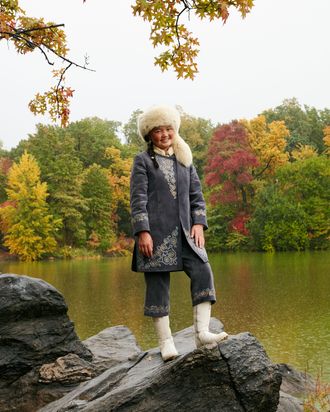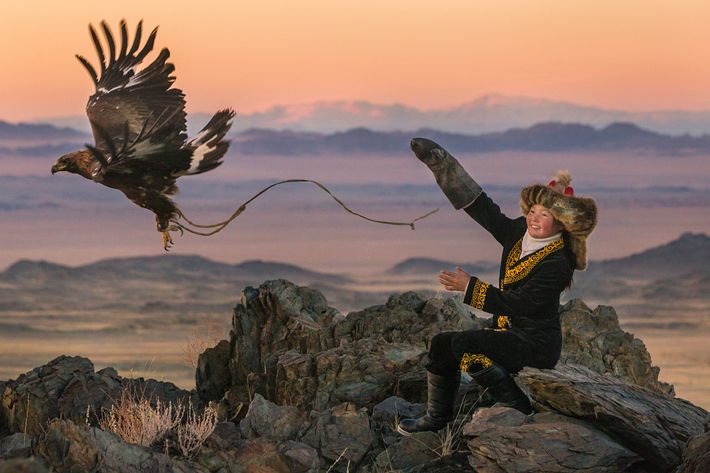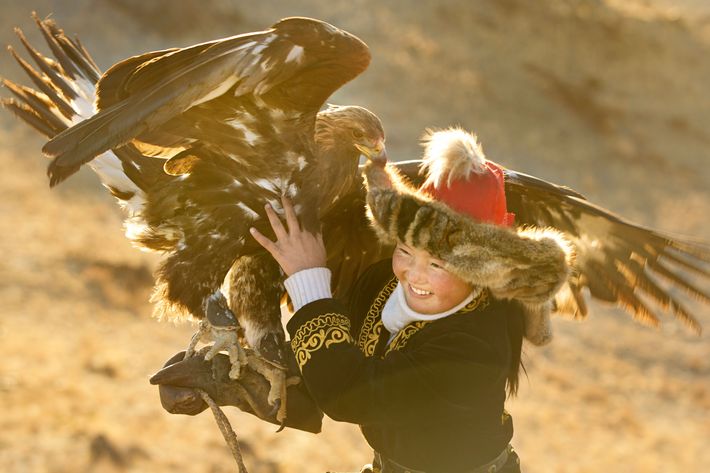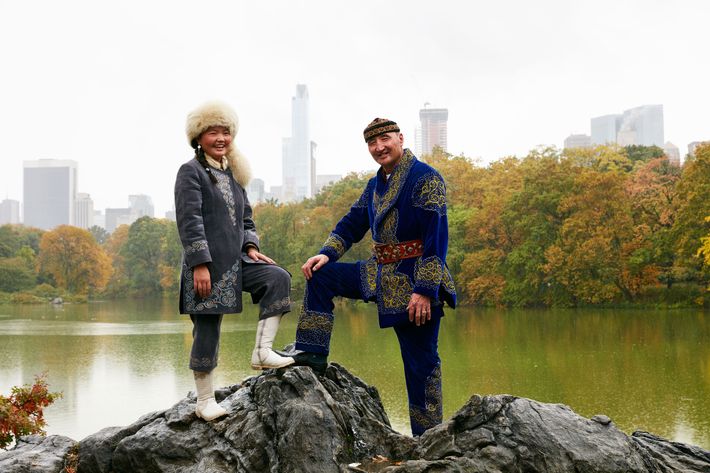
Nurgaiv Rys, a nomadic eagle hunter from the
remote Altai mountains in Mongolia, didn’t set out to take on the Kazakh patriarchy. When his 13-year-old daughter, Aisholpan, asked if she could hunt with golden eagles — a practice passed down through the men in their family for 12 generations — he did not envision how their story would resonate with viewers across the world. He simply believed that Aisholpan should be able to do whatever the boys could do.
“People say she should not be doing this, so I worry for her,” explains Nurgaiv in a new documentary about his daughter, The Eagle Huntress, out this week. “But I think boys and girls are equal.” Directed by English filmmaker Otto Bell and executive-produced by Morgan Spurlock and Daisy Ridley (who also serves as narrator), The Eagle Huntress details Aisholpan’s quest to continue her family’s legacy, traditional gender roles be damned.
Bell first discovered Aisholpan after seeing a series of viral photographs by Israeli photographer Asher Svidensky in 2014. It’s not hard to see why the photo resonated with the likes of Bell and Ridley (as well as Sia, who wrote the movie’s theme song): Clad in her
traditional hunting garb, a 15-pound eagle leaping from her outstretched hand, Aisholpan looks like like a heroine dreamed up in the laboratories of Disney or Pixar, a ready-made avatar of feel-good Girl Power. Fortunately, the story is just as good as the pictures.

Shot amid the soaring mountain vistas of western Mongolia, the film chronicles then-13-year-old Aisholpan’s quest to capture an eagle of her own, hunting on horseback with her father, and her eventual journey to the Golden Eagle Festival in Ölgii, where she is both the youngest contestant and the first woman ever to take part. A mode of hunting dating back thousands of years, eagle hunting is a form of falconry that involves riding on horseback and catching small prey with a trained bird as one’s companion. Once used to catch food and fur, eagle hunting now lives on as an important cultural tradition. “It’s very much a tradition tied up with men’s self-identity. It goes beyond being a sport or pastime or hobby,” says Bell. “There’s almost a spiritual aspect as well.”
Throughout the film, we hear testimony from a gaggle of scowling elders, who scoff at the idea that a girl would be “brave enough” to try her hand at this male-dominated pastime (while there is some record of eagle huntresses in Kazakh history, they are few and far between). But Aisholpan appears unruffled by their criticism.
“From an early age I was always interested to be an eagle huntress,” says Aisholpan, now 15, speaking through a translator at New York’s Crosby Hotel last week. “I was wondering why I can’t do this because I don’t see any differences between me and the other boys.”
In 2014, Bell flew to Mongolia to meet with the family, and the timing was fortuitous: Aisholpan and her dad were about to go find her a baby eagle of her own, a task only possible during the short window of time eaglets are old enough to be left in the nest unattended. In the film, we see Nurgaiv tie a rope around his daughter’s waist, and then watch her wind dexterously down the side of a steep cliff face in order to swaddle her eaglet in a blanket. Aisholpan never expresses doubt or fear, never tires, never complains. “At first I was a little bit excited and worried, but I wasn’t afraid,” she tells me of the fateful day she met her eagle, a female named White Wings, who lives in the family’s yurt with them (female eagles are generally bigger, stronger, and better for hunting — take from that what you will).
“Since the first time I took the eagle from the nest we’ve been always together. I’ve always been feeding her and spoiling her,” she explains. In the film, we see her rearing White Wings almost like a child, stroking her and speaking to her in soft baby talk. “Right now I think that she’s my friend and also a member of the family.”

Bell attributes Aisholpan’s success both to her singular determination and to the support of her father, who mentored her and shielded her from the criticisms of the men in the community. “To a man, the interviews I did with the elders, they rejected the idea of a woman stepping into their realm,” explains Bell. “I think her dad did a lot to insulate her from the people saying she couldn’t do it and wasn’t capable enough.”
By the sheer force of their example, Nurgaiv and Aisholpan have dealt a blow to the eagle-hunting patriarchy. After months of training, Aisholpan competed at the Golden Eagle Festival against 70 full-grown men and came out victorious. Since then, four other young girls have competed at the festival, following in her footsteps. Aisholpan has become something of a community hero, and her newfound fame earned her a scholarship to a top school in the region, where she is studying to be a doctor and learning to speak English.
Meanwhile, around the world, people have latched on to Aisholpan’s story as an example that girls can indeed do anything boys can do — even if the mountains they have to climb aren’t quite so literal. Next, her story is slated to get the animated treatment, courtesy of Ice Age’s Chris Wedge, so it’s not hard to imagine Kmart one day stocking Aisholpan dolls along with its Annas and Elsas.
Aisholpan says she is happy that girls around the world have been inspired by her story, and encourages them simply to keep persevering when times get tough. “They must keep trying and be brave,” she says.





